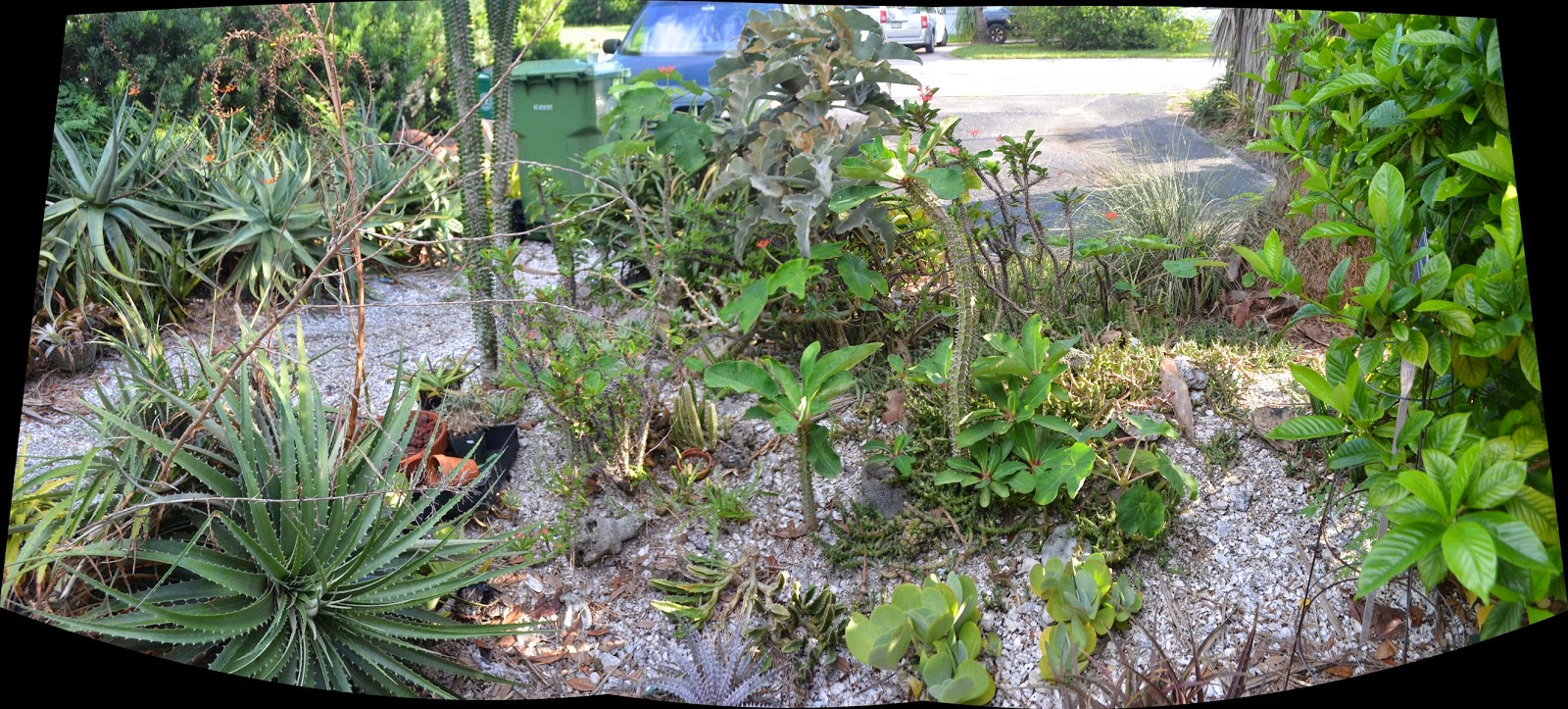I have one but what do I do with it?
xEnchotia Ruby is Encholirium horridum x Hechtia rosea
From BSI. org:
Bromeliad Cultivar
Register
Spineless mature terrestrial rosette to 1.5 metres diameter x 1 metre tall.
Arching bronze green leaves each 110 cms. long x 6cms. wide tapering to a
point. Massive, erect inflorescence to 1.75 metres high, red-stemmed and
multi-branched with ruby sepals and suffused red / pink / cream petals.
Tropiflora code #5739. Reg. Doc. 8/2011 by Dennis Cathcart
Country of origin: Florida USA
Seed Parent: Encholirium horridum
Pollen Parent: Hechtia rosea
NOTES
New Bigeneric genus: x Enchotia by Geoff Lawn in J Brom
Soc 61(3): 138. 2011 In August, 2011 the nothogenus x Enchotia ( Encholirium x
Hechtia) was first recorded in the BSI's Bromeliad
Cultivar Register under ICBN Rules (Vienna Code 2006) . Its breeder is Ray
Lemieux, employee at Tropiflora Nursery in Sarasota, Florida who created this
cross in February, 2006 and he also coined this new bigeneric genus name x
Enchotia. Seed Parenl: Encholirium horridum L.B. Smith. Contr. Gray Herb .
129:32, pl-3, figs. l-3, 1940. Pollen Parent: Hechtia rosea E. Morren ex Baker.
Handb. Bromel. 140. 1889.
x Enchotia ‘Ruby’
Geoff Lawn
BSI Cultivar Registrar
It took Florida breeder Ray Lemieux “only” 5 years of
cultivation (2006-2011) from seed to produce the first blooming new bigeneric x
Enchotia ’Ruby’ (Encholirium horridum x Hechtia
rosea ). Considering that both parents are heavily spined, the several
dozen seedlings showed a surprising outcome --the majority were spineless, or
nearly so--with a few small random spurs.
A second and third repeat of the cross using different clonal forms of
the same parental species produced similar mixed results. So the smooth edged
clones share the grex name of ‘Ruby’ whilst the prickly forms are collectively
called x Enchotia ‘Ruby Star’, both
of which greges may exhibit slight clonal variances at maturity. This
phenomenon of spineless progeny from prickly parents has become rather common
in, for example, Aechmea fasciata cultivars
or hybrids, but is less seen in the Pitcairnioideae sub-family genera. Noted
smooth-edged exceptions are Dyckia ’Naked Lady’ ( encholirioides x brevifolia), Dyckia hebdingii
hybrids and some Encholirium crosses (pers.
comm.--Dennis Cathcart).
Under good growing conditions x Enchotia ‘Ruby’ is a large terrestrial, the mature rosette reaching
1.5 metres diameter and nearly 1 metre tall.
The arching bronze green foliage comprises about 150 smooth leaves each
6cms. wide tapering to a point and to 110cms. long. The erect inflorescence stem, 5cms. thick at
its base, rises to 1.75 metres average height above the rosette crown.. The
massive red-stemmed raceme has up to 32 branches with ruby sepals and suffused
red/pink/cream petals, indicative of its hybrid genes. The spike is initiated
mid-Winter and blooming lasts about 8 weeks over Spring. When the inflorescence is spent and
preferably removed, basal pups emerge slowly between lower leaf axils, or are
visible from the main stem if lower leaves are stripped to allow more light and
encourage offsets.
x Enchotia ’Ruby’
is destined to mound into tight clumps if not divided, just as with its pollen
parent Hechtia rosea , now classified
as synonymous with former H.
macdougallii L. B. Smith. This tough
Mexican species hails from Oaxaca State
and is dioecious, meaning male and female flowers are on separate, individual
plants, as are all Hechtias. The seed parent Encholirium horridum , a lithophyte from Espirito
State, Brazil
is mostly monocarpic --rarely or never offsets.
Undoubtedly x Enchotia
’Ruby’ will become a staple, sun-loving feature xerophyte planted in the
garden landscape, adaptable to tropical,
sub-tropical and temperate climates, but also can be grown in extra large
soil-filled containers for full sunlight positions.
Published in BSI Journal, May-June, 2011. pp.138-140.
Below is Encholirium horridum x Hechtia macdougallii old label the new label should read Encholirium horridum x Hechtia rosea
 |
| Photo from 2009 at Tropiflora |
Hechtia macdougallii is now Hechtia rosea
 |
| Photo from 2009 at Tropiflora |




